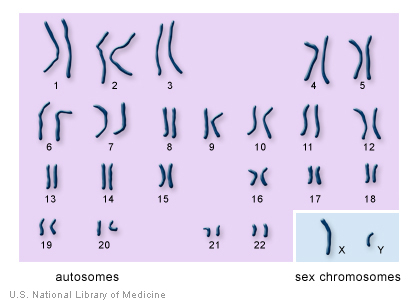Their differences don't stop there. Chromosome pairs are numbered according to size, pair 1 being largest and 23 the smallest. And the Y is tiny compared to the X. X contains thousands of genes critical for life while the Y provides the instructions for initiating male development and making sperm.
Exactly how they work together during meiosis, the form of cell division that creates sperm and egg, contains a science mystery.
A new study (in mice, which are obviously not humans) finds that one clue to solving it is a very deliberate breaking and rejoining of DNA.

During this process, every chromosome we got from our mothers lines up with every chromosome we got from our fathers and the two swap segments. Before this swapping can occur, the DNA in the chromosomes must be deliberately broken. The regions that are swapped are "homologous" -- they're found in the same place along the chromosome and contain the same genes; although the particular DNA sequence of each gene may be slightly different.
Homologous recombination is more challenging for males because most of the X chromosome has nothing to pair with. In fact, only a very tiny portion of the already tiny Y chromosome has any homology with the X. This region is called the pseudoautosomal region (PAR), and it's critical for making sure that X and Y find their way into different sperm cells.
Scientists have known for a long time that the PAR undergoes breaking and swapping of segments at a level that far outpaces what one would expect, given its size. The key to proper pairing of X and Y, they discovered, is a repeated sequence of DNA in the PAR that attracts several double-strand break-related proteins to this region. These protein clusters change the architecture of the chromosome in this region in such a way that the PAR becomes, as the authors put it, "the hottest area of double-strand break formation in the male mouse genome."
These protein clusters were key to understanding how the PAR DNA is tethered as short loops to the linear axis that is the structural backbone of the chromosome. Though the X chromosome also has this same repeated DNA sequence, the two X chromosomes in female meiosis typically do not recombine at this region. Why not? The SKI scientists show that it is because pairing between other regions of the X tends to happen first and directly opposes breakage at the PAR.
This strategy of recruiting more than one's expected share of DNA-breaking proteins may not be limited to the PAR region. Small chromosomes in budding yeast resort to a similar tactic.





Comments